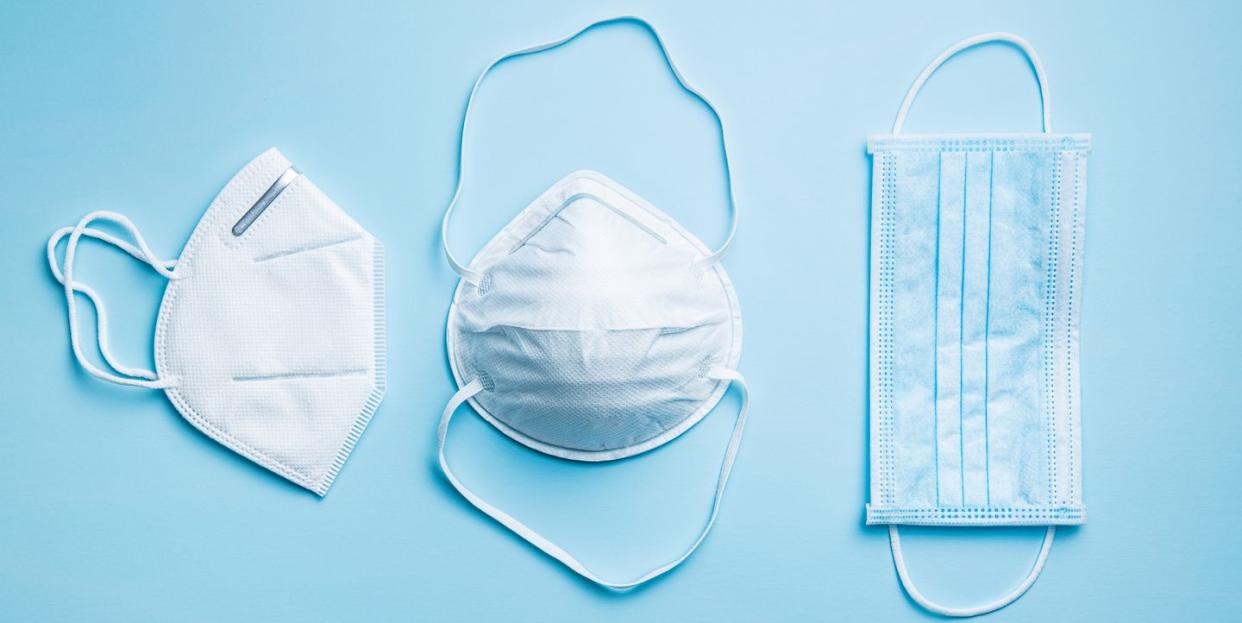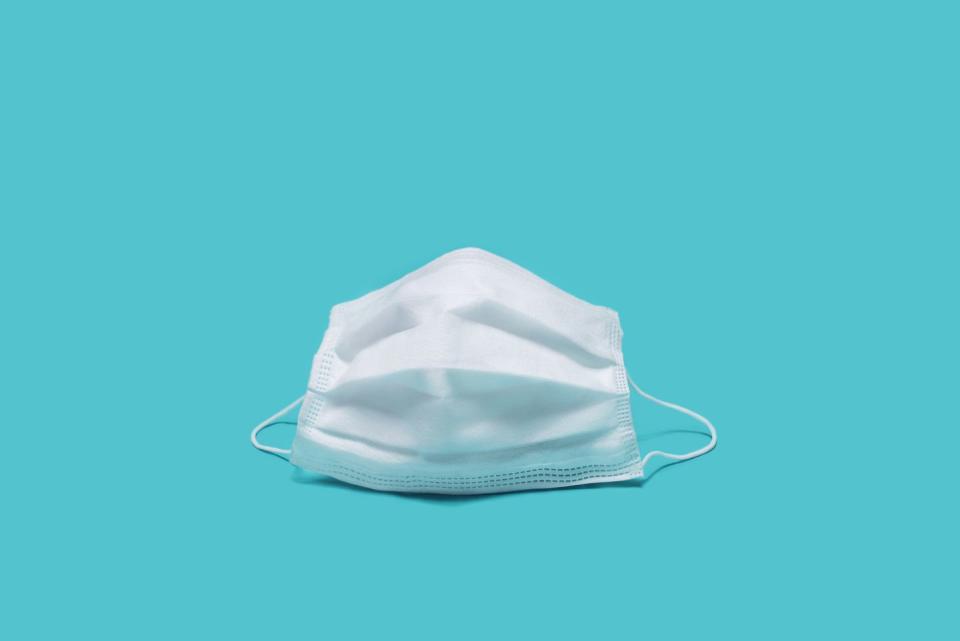With the Delta Variant on the Rise, Experts Explain Why Your Face Mask Is Overdue for an Upgrade

The Centers for Disease Control and Prevention (CDC) has once again overhauled its mask guidance this week, asking all Americans to go back to wearing face masks in indoor public spaces and in crowded outdoor areas, regardless of vaccination status.
The agency's new mask recommendations come as the viral Delta strain of COVID-19 continues to spread, leading to an uptick in new coronavirus cases across the United States. And since vaccines are still being observed in trials for children under 12, CDC officials also updated guidelines asking all students in grades K-12 to mask up while in school this fall.
The Delta variant is more contagious than other forms of SARS-CoV-2, the virus behind the spread of COVID-19. People infected with this strain may carry up to 1,000 times more viral airborne particles in their airways than those infected with earlier versions, according to emerging data. While vaccines prevent most to all of the deadly symptoms associated with COVID-19 illnesses, CDC officials did also recently acknowledge that vaccinated people can indeed spread the disease to others around them.
"The best recommendation would be, regardless of vaccination status, to continue wearing a mask to protect your loved ones and yourself against COVID as an added layer of protection," explains Vivek Cherian, M.D., an internal medicine physician affiliated with the University of Maryland Medical System.
But if you're still wearing the same face masks you rushed to purchase (or even sew yourself) back in the early months of the pandemic, it's important to know these masks are likely less protective than other options available now.
What's the best mask to protect against the Delta variant?
Cloth masks made in the first half of 2020 weren't designed as stringently as they are now, and it wasn't until late 2020 and early 2021 that CDC officials began making more stringent mask recommendations to Americans (like in January, when officials asked Americans to consider double-masking). While cloth masks certainly are better than no mask at all when it comes to preventing the spread of COVID-19, the fit and construction of medical-grade surgical face masks are usually more comprehensive — and currently, they're readily available for consumers.
Good Housekeeping Institute Textiles Director Lexie Sachs says that surgical masks are usually made by PPE manufacturers who adhere to strict quality standards that have been in place since long before the pandemic began. "We know they're typically safer in terms of filtration and fit," Sachs adds, as opposed to cloth masks made by fashion retailers who don't usually deal with medical standards in construction. "They're often more breathable as well."
Most crucially, you can rest assured that the medical-grade surgical mask you're wearing is tested to meet standards set forth by ASTM International, an industry group in charge of establishing safety minimums for many products, including face masks. "You'll know whether or not it's been tested to meet standards — in this case, ASTM Level 3 and more — rather than blindly guessing with most cloth options," Sachs adds.
There are also N95 and KN95 masks, otherwise known as respirators, which are known to be more protective than surgical masks. Why? Because they're carefully engineered to prevent large and small airborne particles from specifically penetrating the masks' front. Mayo Clinic officials clarify that while surgical masks can indeed offer filtration on par with or superior to cloth masks, they are primarily designed to prevent fluids and sprays from landing on the wearer in a clinical setting — not particles or aerosols.
While N95 and KN95 masks were largely unavailable at the start of the pandemic — and officials at the Food and Drug Administration (FDA) still maintain that PPE supply levels are low in crucial categories like respirators — there are more respirator masks available now than there were at the beginning of the outbreak.
In fact, Scott Gottlieb, a former FDA commissioner, recently advised Americans to consider wearing N95 or KN95 masks, sourced from China, to best protect themselves from COVID-19 exposure in public. "If you're going to consider wearing a mask, the quality of the mask does matter," Gottlieb told CBS reporters. "So if you can get your hands on a KN95 mask, or an N95 mask, that's going to afford you a lot more protection."
"There's no question that [respirators] offer the best protection as they fit more securely and also offer high filtration abilities if you are able to secure those masks," explains Dr. Cherian. "However, cloth masks are still an effective option [if you can't find a respirator]."

What's the best mask for my child to wear?
Because N95s are classified as a respirator, you'll need to fit them tightly across your nose and mouth to ensure proper filtration and effectiveness. Product manufacturers usually include directions for mask wearers to ensure they're using an N95 or KN95 correctly, but depending on which respirator you choose, it may be harder to fit the mask properly, explains Charles C. J. Bailey, M.D., an infectious diseases specialist at Providence Mission Hospital in California.
Because of their encompassing fit, Dr. Bailey and other experts caution against children using N95s or KN95s. Respirators can be much harder to breathe in than medical masks or cloth masks, which is especially challenging for kids in active settings or during physical activity. Surgical masks are better suited for children, especially those with respiratory issues or who are particularly active, over ill-fitting N95 or KN95 masks.
Dr. Bailey adds that keeping a perfectly fitted N95 or KN95 on a child would be an impractical challenge, and wearing an ill-fitting respirator won't offer any extra protection over other mask choices (this is also true for adults!). Remember: CDC officials still recommend that any child under the age of two refrain from all masks at this time, including those children with pre-existing respiratory conditions that make masks potentially harmful.
How can I shop for the best mask moving forward?
If you're still using the same cloth masks you purchased in 2020, it may be time to consider swapping them out for a respirator or surgical mask — or, at the very least, a newer cloth-based mask, Sachs says. "The shelf life of a cloth-based mask is typically based on the number of washes, and the brands that conform to ASTM standards should be telling customers this information," she adds.
New ASTM International standards — referred to as ASTM F3502, which will be displayed by manufacturers that engineered and tested their products to meet these quality benchmarks — were drawn up to give designers and lifestyle brands more direction in creating safer non-PPE cloth face masks. These standards ensure the mask will properly fit over your nose and mouth, can filter airborne particles effectively, and are reasonably breathable for consumers. Safety Product Inc.'s AerFit Mask is an example of a cloth mask that has been previously tested and manufactured — you'll see clear language indicating its adherence to ASTM standards.
Manufacturers are slowly adapting the way they make their masks so they can meet the standards set forth by the ASTM; if a favorite mask of yours doesn't yet display any ASTM F3502 classification, it may be that the masks aren't made sufficiently protective to qualify, Sachs explains.
It's also always best to buy new face masks rather than try to repair a torn or stretched face mask. And if anything is clear, it's that the investment in properly constructed face masks will pay off in the end — it looks like these current CDC guidelines will be in place until all children become eligible for vaccines, and possibly until an overwhelming majority of Americans choose to sign up for a vaccine.
As more information about the coronavirus pandemic develops, some of the information in this story may have changed since it was last updated. For the most up-to-date information on COVID-19, please visit online resources provided by the CDC, WHO, and your local public health department.
You Might Also Like